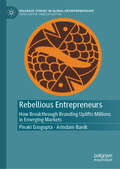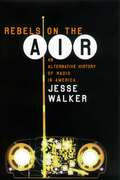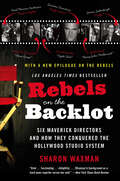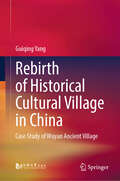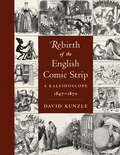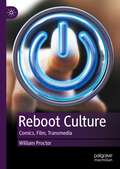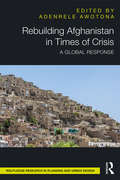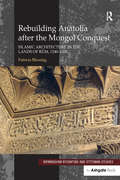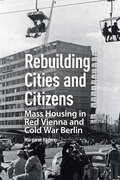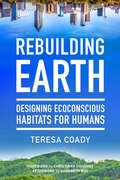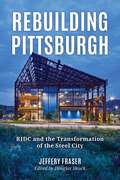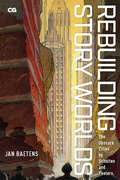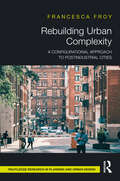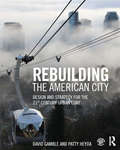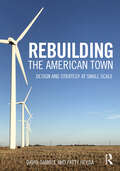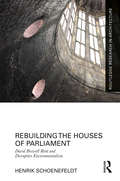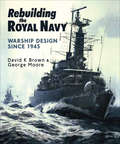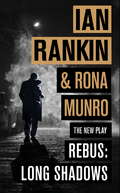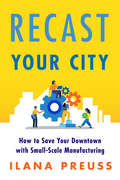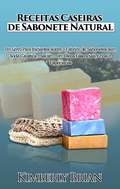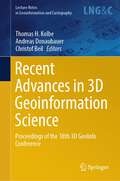- Table View
- List View
Rebellious Entrepreneurs: How Breakthrough Branding Uplifts Millions in Emerging Markets (Palgrave Studies in Global Entrepreneurship)
by Arindam Banik Pinaki DasguptaThis book focuses on entrepreneurship and brand-building processes of businesses in India. It does so by highlighting seven regional entrepreneurs in the country as case studies, and how they have created an ecosystem around them with regard to efficiency in supply chain, excellence in marketing, creating a sustainable environment of doing business, providing gainful employment, working with limited resources and credit, and finally showcasing resilience in their work. Case studies in the book include Hosiery cluster of West Bengal, Tiluram and Sons, Balaji Wafers, Biskfarm (SAJ Foods), Annapurna Group, Shri Krishna Paper Mills Limited, Chitale Bandhu, Phool.co (Kanpur Flower Cycling Private Limited), Walkaroo and Aachi Masale. With these case studies, the book maps out their respective business journeys, elaborates on issues and challenges, to create templates for breakthrough branding, which are can be relevant to other emerging economies and the medium-sized enterprises (SME) sector.
Rebels on the Air: An Alternative History of Radio in America
by Jesse WalkerExplores the alternative radio that refuses to succumb to the big business that monopolizes the airwavesBoring DJs who never shut up, and who don't even pick their own records. The same hits, over and over. A constant stream of annoying commercials. How did radio get so dull? Not by accident, contends journalist and historian Jesse Walker. For decades, government and big business have colluded to monopolize the airwaves, stamping out competition, reducing variety, and silencing dissident voices. And yet, in the face of such pressure, an alternative radio tradition has tenaciously survived. Rebels on the Air explores these overlooked chapters in American radio, revealing the legal barriers established broadcasters have erected to ensure their dominance. Using lively anecdotes drawn from firsthand interviews, Walker chronicles the story of the unsung heroes of American radio who, despite those barriers, carved out spaces for themselves in the spectrum, sometimes legally and sometimes not. Walker's engaging, meticulous account is the first comprehensive history of alternative radio in the United States. From the unlicensed amateurs who invented broadcasting to the community radio movement of the 1960s and 1970s, from the early days of FM to today's micro radio movement, Walker lays bare the hidden history of broadcasting. Above all, Rebels on the Air is the story of the pirate broadcasters who shook up radio in the 1990sand of the new sorts of radio we can expect in the next century, as the microbroadcasters crossbreed with the even newer field of Internet broadcasting.
Rebels on the Backlot: Six Maverick Directors and How They Conquered the Hollywood Studio System
by Sharon WaxmanThe 1990s saw a shock wave of dynamic new directing talent that took the Hollywood studio system by storm. At the forefront of that movement were six innovative and daring directors whose films pushed the boundaries of moviemaking and announced to the world that something exciting was happening in Hollywood. Sharon Waxman, editor and chief of The Wrap.com and for Hollywood reporter for the New York Times spent the decade covering these young filmmakers, and in Rebels on the Backlot she weaves together the lives and careers of Quentin Tarantino, Pulp Fiction; Steven Soderbergh, Traffic; David Fincher, Fight Club; Paul Thomas Anderson, Boogie Nights; David O. Russell, Three Kings; and Spike Jonze, Being John Malkovich.
Rebels, Rogues, and Outlaws: A Pictorial History of WarRoom
by Dan FleuetteAs an artist, Dan Fleuette has always identified with the marginal, the rebels, those at the margins of society. Traditionally, these characters have been artists, musicians, filmmakers, and writers. Since the dawn of woke culture, where many of today&’s artists march in lockstep with the dominant, politically correct corporate news and political space, these marginal characters have taken a different look. Today&’s rebels would have been considered quite mainstream just a few years ago. Included in their ranks are the scorned, mocked, ridiculed and canceled—those who risk everything to dare to speak their mind and run counter to mainstream narratives. These are the people captured in Rebels, Rogues, and Outlaws: A Pictorial History of WarRoom. This is not just a portrait book, it is also a WarRoom historical document showcasing the brave souls who are courageous enough to stand up against a ceaseless and powerful battering of politicians, woke social media tyrants, school boards, editorial pages, and polite society in general. This book is Fleuette&’s small attempt to honor these people, who show us, day in and day out, what real courage is.
Rebirth of Historical Cultural Village in China: Case Study of Wuyan Ancient Village
by Guiqing YangThis book combines theory and practice with typical cases study. Pictures and texts are listed in each chapter for easier understanding. It is suitable for undergraduate and graduate students majoring in urban and rural planning, architecture, and landscape architecture in colleges and universities. It is used as a reference material for personnel engaged in rural planning, design, construction and management, and for the training and learning of rural cadres. Meanwhile, it is also used as a reference for general audience who interested in rural planning and construction. This book hopefully promotes the academic exchange and discussion of the rebirth of mountainous historical and cultural villages in eastern China, encouraging the further localized practice and more attention to historical and cultural villages.
Rebirth of the English Comic Strip: A Kaleidoscope, 1847-1870
by David KunzleRebirth of the English Comic Strip: A Kaleidoscope, 1847–1870 enters deep into an era of comic history that has been entirely neglected. This buried cache of mid-Victorian graphic humor is marvelously rich in pictorial narratives of all kinds. Author David Kunzle calls this period a “rebirth” because of the preceding long hiatus in use of the new genre, since the Great Age of Caricature (c.1780–c.1820) when the comic strip was practiced as a sideline. Suddenly in 1847, a new, post-Töpffer comic strip sparks to life in Britain, mostly in periodicals, and especially in Punch, where all the best artists of the period participated, if only sporadically: Richard Doyle, John Tenniel, John Leech, Charles Keene, and George Du Maurier. Until now, this aspect of the extensive oeuvre of the well-known masters of the new journal cartoon in Punch has been almost completely ignored. Exceptionally, George Cruikshank revived just once in The Bottle, independently, the whole serious, contrasting Hogarthian picture story. Numerous comic strips and picture stories appeared in periodicals other than Punch by artists who were likewise largely ignored. Like the Punch luminaries, they adopt in semirealistic style sociopolitical subject matter easily accessible to their (lower-)middle-class readership. The topics covered in and out of Punch by these strips and graphic novels range from French enemies King Louis-Philippe and Emperor Napoleon III to farcical treatment of major historical events: the Bayeux tapestry (1848), the Great Exhibition of 1851, and the Franco-Prussian War in 1870. Artists explore a great variety of social types, occupations, and situations such as the emigrant, the tourist, fox hunting and Indian big game hunting, dueling, the forlorn lover, the student, the artist, the toothache, the burglar, the paramilitary volunteer, Darwinian animal metamorphoses, and even nightmares. In Rebirth of the English Comic Strip, Kunzle analyzes these much-neglected works down to the precocious modernist and absurdist scribbles of Marie Duval, Europe’s first female professional cartoonist.
Reboot Culture: Comics, Film, Transmedia
by William ProctorSince the release of Christopher Nolan’s Batman Begins in 2005, there has been a pronounced surge in alternative uses of the computer term ‘reboot,’ a surge that has witnessed the term deployed in new contexts and new signifying practices, involving politics, fashion, sex, nature, sport, business, and media. As a narrative concept, however, reboot terminology remains widely misused, misunderstood, and misinterpreted across popular, journalistic, and academic discourses, being recklessly and relentlessly solicited as a way to describe a broad range of narrative operations and contradictory groupings, including prequels, sequels, adaptations, revivals, re-launches, generic ‘refreshes,’ and enactments of retroactive continuity. Adopting an inter-disciplinary approach that fuses cultural studies, media archaeology, and discursive approaches, this book challenges existing scholarship on the topic by providing new frameworks and taxonomies that illustrate key differences between reboots and other ‘strategies of regeneration,’ helping to spotlight the various ways in which the culture industries mine their intellectual properties in distinct and novel ways to present them anew. Reboot Culture: Comics, Film, Transmedia is the first academic study to critically explore and interrogate the reboot phenomenon as it emerged historically to describe superhero comics that sought to jettison existing narrative continuity in order to ‘begin again’ from scratch.of franchising in the twenty-first century. of franchising in the twenty-first century.
Rebuilding Afghanistan in Times of Crisis: A Global Response
by Adenrele AwotonaRebuilding Afghanistan in Times of Crisis provides academics and researchers interested in planning, urbanism and conflict studies with a multidisciplinary, international assessment of the reconstruction and foreign aid efforts in Afghanistan. The book draws together expert contributions from countries across three continents – Asia, Europe and North America – which have provided external aid to Afghanistan. Using international, regional and local approaches, it highlights the importance of rebuilding sustainable communities in the midst of ongoing uncertainties. It explores the efficacy of external aid; challenges faced; the response of multilateral international agencies; the role of women in the reconstruction process; and community-based natural disaster risk management strategies. Finally, it looks at the lessons learned in the conflict reconstruction process to better prepare the country for future potential human, economic, infrastructural and institutional vulnerabilities.
Rebuilding Anatolia after the Mongol Conquest: Islamic Architecture in the Lands of Rum, 1240–1330 (Birmingham Byzantine and Ottoman Studies #17)
by Patricia BlessingThis book is a study of Islamic architecture in Anatolia following the Mongol conquest in 1243. Complex shifts in rule, movements of population, and cultural transformations took place that affected architecture on multiple levels. Beginning with the Mongol conquest of Anatolia, and ending with the demise of the Ilkhanid Empire, centered in Iran, in the 1330s, this book considers how the integration of Anatolia into the Mongol world system transformed architecture and patronage in the region. Traditionally, this period has been studied within the larger narrative of a progression from Seljuk to Ottoman rule and architecture, in a historiography that privileges Turkish national identity. Once Anatolia is studied within the framework of the Mongol Empire, however, the region no longer appears as an isolated case; rather it is integrated into a broader context beyond the modern borders of Turkey, Iran, and the Caucasus republics. The monuments built during this period served a number of purposes: mosques were places of prayer and congregation, madrasas were used to teach Islamic law and theology, and caravanserais secured trade routes for merchants and travelers. This study analyzes architecture on multiple, overlapping levels, based on a detailed observation of the monuments. The layers of information extracted from the monuments themselves, from written sources in Arabic, Persian, and Turkish, and from historical photographs, shape an image of Islamic architecture in medieval Anatolia that reflects the complexities of this frontier region. New patrons emerged, craftsmen migrated between neighboring regions, and the use of locally available materials fostered the transformation of designs in ways that are closely tied to specific places. Starting from these sources, this book untangles the intertwined narratives of architecture, history, and religion to provide a broader understanding of frontier culture in the medieval Middle East, with its complex interaction of local, regional, and trans-regional identities.
Rebuilding Cities and Citizens: Mass Housing in Red Vienna and Cold War Berlin
by Margaret HadererIn Vienna after WWI and Berlin after WWII, the provision of mass housing not only was a response to a dire social need but also served as a key lever for building variants of socialism and liberalism. Zooming into the interplay between political ideologies and the production of space, this book shows that ideologies, understood as political beliefs that underpin everyday life, are never simply ‘written’ into space but that their meaning is made and re-made, negotiated and contested, and sometimes cunningly subverted in and through space. How people live was – and continues to be – a profoundly political question that involves negotiations of, and decisions on, norms and ideals of citizenship, freedom, equality, property, democracy, gender, and family life – negotiations and decisions that come with legacies that shape the present.
Rebuilding Earth: Designing Ecoconscious Habitats for Humans
by Teresa CoadyA revolutionary guide to designing humane, eco-conscious homes, buildings, and cities of the future.It is estimated that the earth's population will expand to an unprecedented nine billion people over the next century. This explosion in population is predicted to place further stress on our environment, deplete our natural resources, and lead to increases in anxiety and depression due to overcrowding. In this visionary and uplifting book, Teresa Coady offers readers new hope. Rebuilding Earth is her blueprint for designing and building the cities, buildings, and homes of tomorrow, resulting in more conscious, sustainable, and humane living. Coady shows us how we can shift from an outdated Industrial-Age framework to a more humane, Digital-Age framework. This revolutionary approach will enable communities to harness various forms of green energy and reduce the amount of material needed to build infrastructure while contributing to a healthier planet (and society). We can then experience a new sense of purpose, health, and happiness. Meaningful and lasting change, the author tells us, can only come through designing interconnected communities that are vibrant, resilient, and communal. Unlike most predictions of doom and gloom, Coady presents a refreshingly optimistic view of humanity and its future. This book will appeal to those in the construction, design and development finance industries, as well as anyone interested in improving their lives through understanding the connections between the environment and health.
Rebuilding Pittsburgh: RIDC and the Transformation of the Steel City
by Jeffery FraserThe Regional Industrial Development Corporation of Southwestern Pennsylvania is a nonprofit organization that has played an integral part in rebuilding the Pittsburgh region&’s economy over the course of eight decades. This book showcases the efforts of RIDC to renew and improve the Pittsburgh region. From revitalizing abandoned steel mills and industrial sites into thriving business and technology parks to transforming underutilized land into locations built for job-creating companies, the organization has created a unique blend of economic development advocacy, community and regional revitalization, and high quality job creation that could be a model for other regions that were once powerhouses of America&’s industrial economy. Inside, you&’ll learn more about: The history and future of the Pittsburgh region&’s economy The shift from factories and mills to artificial intelligence, robots, and life sciences The process of revitalization and the people behind the diversification of Pittsburgh&’s economy
Rebuilding Story Worlds: The Obscure Cities by Schuiten and Peeters (Critical Graphics)
by Jan BaetensA collaboration between Belgian artist François Schuiten and French writer Benoît Peeters, The Obscure Cities is one of the few comics series to achieve massive popularity while remaining highly experimental in form and content. Set in a parallel world, full of architecturally distinctive city-states, The Obscure Cities also represents one of the most impressive pieces of world-building in any form of literature. Rebuilding Story Worlds offers the first full-length study of this seminal series, exploring both the artistic traditions from which it emerges and the innovative ways it plays with genre, gender, and urban space. Comics scholar Jan Baetens examines how Schuiten’s work as an architectural designer informs the series’ concerns with the preservation of historic buildings. He also includes an original interview with Peeters, which reveals how poststructuralist critical theory influenced their construction of a rhizomatic fictional world, one which has made space for fan contributions through the Alta Plana website. Synthesizing cutting-edge approaches from both literary and visual studies, Rebuilding Story Worlds will give readers a new appreciation for both the aesthetic ingenuity of The Obscure Cities and its nuanced conception of politics.
Rebuilding Urban Complexity: A Configurational Approach to Postindustrial Cities (Routledge Research in Planning and Urban Design)
by Francesca FroyThis is a book about urban complexity – how it evolves and how it gets destroyed. It explores the structures of interdependency which underpin cities, where the many different “parts” (people, streets, industry sectors) interact to form an evolving “whole”.The book explores the evolution and destruction of complexity in one city – Greater Manchester – but also other post-industrial cities, including Sheffield and Newcastle, Detroit and New Haven. The focus is on the networked qualities of public urban space, and how street networks work as multiscale systems. The book also explores economic networks, and the evolving sets of interconnecting economic capabilities which help to shape urban economies. It demonstrates how cities evolve through processes of self-organisation – and concludes by considering how policy makers can best harness such processes as they rebuild urban complexity following insensitive planning interventions in the 1960s and 1970s.The book will appeal to anybody with an interest in cities, and how they work. It is interdisciplinary in scope, weaving in strands from architecture, economics, history, anthropology and ecology. It is written for academics but also non-academics, including urban planners, architects, local economic development actors and other policy makers.
Rebuilding the American City: Design and Strategy for the 21st Century Urban Core
by David Gamble Patty HeydaUrban redevelopment in American cities is neither easy nor quick. It takes a delicate alignment of goals, power, leadership and sustained advocacy on the part of many. Rebuilding the American City highlights 15 urban design and planning projects in the U.S. that have been catalysts for their downtowns—yet were implemented during the tumultuous start of the 21st century. The book presents five paradigms for redevelopment and a range of perspectives on the complexities, successes and challenges inherent to rebuilding American cities today. Rebuilding the American City is essential reading for practitioners and students in urban design, planning, and public policy looking for diverse models of urban transformation to create resilient urban cores.
Rebuilding the American Town: Design and Strategy at Small Scale
by David Gamble Patty HeydaIn the scholarship of urbanism, small towns are overlooked and understudied. Rebuilding the American Town highlights how smaller municipalities are transforming to serve their communities and meet the future. The book uncovers creative planning and design strategies of nine U.S. towns as they rebuild to remain vibrant, equitable and viable in the face of metropolitan sprawl, population shifts, political division, economic shortfalls and climate change. Rebuilding the American Town includes interviews and insights from those directly involved, to reveal the challenges and advantages of being a smaller city while highlighting the power of design at local levels.The book provides a new lens for contemporary urbanism more broadly as it shifts thinking away from large-metro concerns, toward novel, tactical strategies that advance the quality of life for residents through design and policies that are scaled to the populations and places they serve. The projects in this book show how the small town in the United States is unexpectedly progressive, experimental, urban and global.
Rebuilding the Houses of Parliament: David Boswell Reid and Disruptive Environmentalism (Routledge Research in Architecture)
by Henrik SchoenefeldtRebuilding the Houses of Parliament explores the history of the UK Houses of Parliament in Westminster from an environmental design perspective, and the role David Boswell Reid played in the development of the original ventilation and climate control system in parliament. This book retraces and critically examines the evolution of the environmental principles underlying the design of the Houses of Parliament, engaging with fundamental questions about air quality, energy efficiency and thermal comfort. This yields insights into the historic methods of environmental design that were characterised by physical experimentation and post-occupancy evaluation. Rebuilding the Houses of Parliament examines the history of the buildings’ operation, studying the practical reality of its performance in use and offers the opportunity to reflect on current challenges faced by architects and engineers adapting to the realities of climate change. This book is an ideal read for academics, politicians and practitioners with an interest in architectural history and heritage, theory, engineering and conservation.
Rebuilding the Royal Navy: Warship Design Since 1945
by George Moore David K. BrownThis design history of post-war British warship development, based on both declassified documentation and personal experience, is the fourth and final volume in the authors masterly account of development of Royal Navys ships from the 1850s to the Falklands War. In this volume the author covers the period in which he himself worked as a Naval Constructor, while this personal knowledge is augmented by George Moores in-depth archival research on recently declassified material.The RN fleet in 1945 was old and worn out, while new threats and technologies, and post-war austerity called for new solutions. How designers responded to these unprecedented challenges is the central theme of this book. It covers the ambitious plans for the conversion or replacement of the bigger ships; looks at all the new construction, from aircraft carriers, through destroyers and frigates, to submarines (including nuclear and strategic), to minesweepers and small craft. The authors pay particular attention to the innovations introduced, and analyses the impact of the Falklands War.At the start of the twenty-first century the Royal Navy is still a powerful and potent force with new and a number of innovative classes, both surface and sub-surface, coming on stream. This book offers a fascinating insight into how the post-war fleet developed and adapted to the changing role of the Navy.
Rebus: The New Play
by Ian RankinFrom the No.1 bestselling author of A SONG FOR THE DARK TIMESThe stage debut for the legendary detective John Rebus in this brand new, original story by Ian Rankin, written alongside the award-winning playwright Rona Munro.John Rebus is not as young as he was, but his detective instincts have never left him. And after the daughter of a murder victim turns up outside his flat, he's going to need them at their sharpest.Enlisting the help of his old friend DI Siobhan Clarke, Rebus is determined to solve this cold case once and for all. But Clarke has problems of her own, problems that will put her at odds with her long-time mentor and push him into seeking help from his age-old adversary: 'Big Ger' Cafferty.This haunting story takes Rebus to places he has never been before, sets him and his long-time foe on a collision course and takes us deeper into one of the most satisfying conflicts in modern fiction.Featuring an introduction from Rankin himself, a Q&A between writers Ian and Rona, an interview with the director, and behind-the-scenes production materials, this book is one Rebus fans will not want to miss out on.
Rebus: The New Play
by Ian RankinFrom the No.1 bestselling author of A SONG FOR THE DARK TIMESThe stage debut for the legendary detective John Rebus in this brand new, original story by Ian Rankin, written alongside the award-winning playwright Rona Munro.John Rebus is not as young as he was, but his detective instincts have never left him. And after the daughter of a murder victim turns up outside his flat, he's going to need them at their sharpest.Enlisting the help of his old friend DI Siobhan Clarke, Rebus is determined to solve this cold case once and for all. But Clarke has problems of her own, problems that will put her at odds with her long-time mentor and push him into seeking help from his age-old adversary: 'Big Ger' Cafferty.This haunting story takes Rebus to places he has never been before, sets him and his long-time foe on a collision course and takes us deeper into one of the most satisfying conflicts in modern fiction.Featuring an introduction from Rankin himself, a Q&A between writers Ian and Rona, an interview with the director, and behind-the-scenes production materials, this book is one Rebus fans will not want to miss out on.
Recast Your City: How to Save Your Downtown with Small-Scale Manufacturing
by Ilana PreussIn Recast Your City: How to Save Your Downtown with Small-Scale Manufacturing, community development expert Ilana Preuss explains how local leaders can revitalize their downtowns or neighborhood main streets by bringing in and supporting small-scale manufacturing. Small-scale manufacturing businesses help create thriving places, with local business ownership opportunities and well-paying jobs that other business types can't fulfill.Preuss draws from her experience working with local governments, large and small, from Knoxville, Tennessee, to Columbia, Missouri, to Fremont, California. She provides tools, such as her five-step method for recasting your city, that local leaders in government, business, and real estate as well as entrepreneurs and advocates in every community can use.
Receitas Caseiras de Sabonete Natural: Um livro para iniciantes sobre produção de sabonetes sem soda cáustica
by Kimberly BrianAproveite os benefícios de saúde dos sabonetes naturais caseiros que garantem uma pele brilhante, radiante, tonificada e saudável! Você recentemente foi à loja para comprar objetos pessoais e, ao chegar à prateleira de sabonete ... tudo o que você vê são sabonetes feitos com substâncias sintéticas. Não se preocupe, este livro é um guia para iniciantes em "Receitas caseiras de sabonetes naturais: um livro para iniciantes sobre fabrico de sabonetes sem soda cáustica, mas com óleos essenciais, ervas e especiarias". O fabrico de sabonete é uma arte que tem a ver com criatividade e trabalho que traz alegria à alma e ao espírito. Este livro ensina como fazer sabão em casa com ingredientes naturais e sem soda cáustica. Todas as receitas são feitas com ingredientes naturais que incluem azeite, óleo de pêssego, óleo de espinheiro e muitos outros óleos que tendem a nutrir, rejuvenescer e curar rugas na pele. Outros benefícios das receitas de sabonete do livro incluem a limpeza da pele, a secura e a eliminação da descamação da pele. Você tem a liberdade de explorar sua criatividade com a lista do livro, pois não está a usar soda cáustica. As receitas deste livro são para: Pele madura, Pele seca, Pele macia, Barras de sabonete, Sabonete para mãos... Não procure mais! Comece a colher os benefícios de saúde de ingredientes orgânicos frescos. Faça o download da sua cópia agora e comece a jornada para ter o seu próprio sabonete caseiro natural sem soda cáustica!
Receitas De Cremes Corporais Orgânicos
by Ashley Andrews Patrícia PintoHidrate o seu corpo e consiga uma pele nutrida com estas receitas de cremes corporais caseiros DIY. Nada no mundo se pode comparar ao sentimento da aplicação de um creme corporal incrivelmente suave e nutritivo para a sua pele, após um banho quente. Com uma consistência de chantilly e uma fragrância delicada, estes cremes corporais têm uma longa história de condicionar e nutrir os nossos corpos cansados e desidratados. Então, porque é, exatamente, que estes cremes são um deleite tão sumptuoso para a nossa pele? Quais são os seus ingredientes constituintes? Será que o creme corporal farmacêutico difere do caseiro? Finalmente, e o mais importante, será possível fazer os nossos próprios cremes corporais, seguros e saudáveis, no conforto da nossa própria cozinha? Com os Cremes Corporais Orgânicos vai encontrar as respostas a todas essas perguntas, ao elucidar-se sobre os seus ingredientes constituintes, os seus usos e benefícios. Inclui 30 Receitas de Cremes Corporais Género: Artesanato e Hobbies / Geral Línguas: Inglesa, Português Europeu e outras traduções em decurso. Número de páginas: 60
Recent Advanced in Image Security Technologies: Intelligent Image, Signal, and Video Processing (Studies in Computational Intelligence #1079)
by Hang Chen Zhengjun LiuThis book provides the readers with a comprehensive overview of principles methodologies and recent advances in image, signal, and video processing using different system. This book is used as the handbook of postgraduates course, such as image processing, signal processing, and optical information security.
Recent Advances in 3D Geoinformation Science: Proceedings of the 18th 3D GeoInfo Conference (Lecture Notes in Geoinformation and Cartography)
by Thomas H. Kolbe Andreas Donaubauer Christof BeilThe book includes the contributions to the international conference “18th 3D GeoInfo”. The papers published in the book were selected through a double-blind review process. 3D GeoInfo has been the forum joining researchers, professionals, software developers, and data providers designing and developing innovative concepts, tools, and application related to 3D geo data processing, modeling, management, analytics, and simulation. A big focus is on topics related to data modeling for 3D city and landscape models as well as their many and diverse applications. This conference series is very successfully running since 2006 and has been hosted by countries in Europe, Asia, Africa, North America, and Australia. In the period 2006 to 2017, the proceedings has been published by Springer in this series with Thomas H. Kolbe being the editor of the 2010 edition of the conference proceedings. 18th 3DGeoInfo was organized by Technical University of Munich in cooperation with the German Society for Photogrammetry, Remote Sensing and Geoinformation (DGPF), the local associations Runder Tisch GIS e.V. (Round Table GIS) and Leonhard Obermeyer Center—TUM Center of Digital Methods for the Built Environment, and the City of Munich. The international program committee consisted of committee members of previous 3D GeoInfo conferences and further leading scientists in the field of 3D Geoinformation Science.
